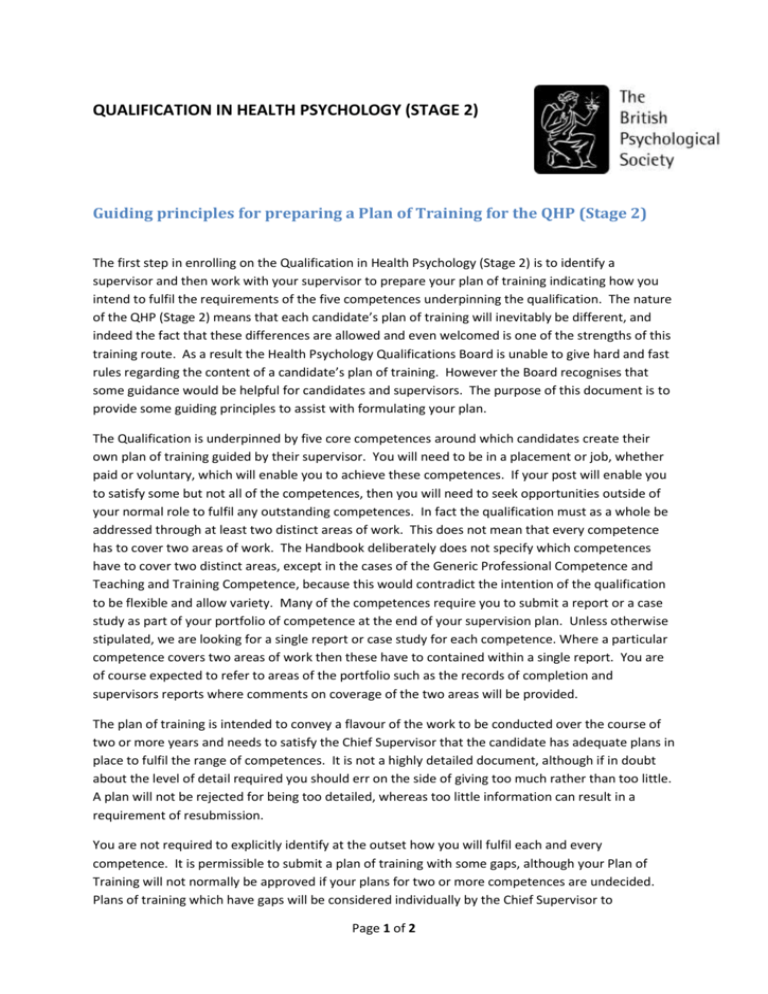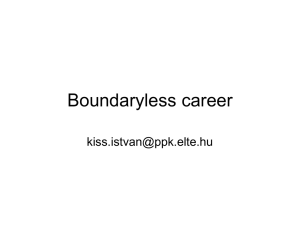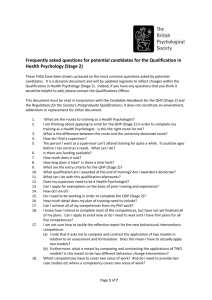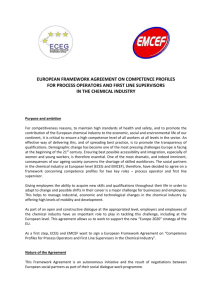Guiding principles for preparing a Plan of Training
advertisement

QUALIFICATION IN HEALTH PSYCHOLOGY (STAGE 2) Guiding principles for preparing a Plan of Training for the QHP (Stage 2) The first step in enrolling on the Qualification in Health Psychology (Stage 2) is to identify a supervisor and then work with your supervisor to prepare your plan of training indicating how you intend to fulfil the requirements of the five competences underpinning the qualification. The nature of the QHP (Stage 2) means that each candidate’s plan of training will inevitably be different, and indeed the fact that these differences are allowed and even welcomed is one of the strengths of this training route. As a result the Health Psychology Qualifications Board is unable to give hard and fast rules regarding the content of a candidate’s plan of training. However the Board recognises that some guidance would be helpful for candidates and supervisors. The purpose of this document is to provide some guiding principles to assist with formulating your plan. The Qualification is underpinned by five core competences around which candidates create their own plan of training guided by their supervisor. You will need to be in a placement or job, whether paid or voluntary, which will enable you to achieve these competences. If your post will enable you to satisfy some but not all of the competences, then you will need to seek opportunities outside of your normal role to fulfil any outstanding competences. In fact the qualification must as a whole be addressed through at least two distinct areas of work. This does not mean that every competence has to cover two areas of work. The Handbook deliberately does not specify which competences have to cover two distinct areas, except in the cases of the Generic Professional Competence and Teaching and Training Competence, because this would contradict the intention of the qualification to be flexible and allow variety. Many of the competences require you to submit a report or a case study as part of your portfolio of competence at the end of your supervision plan. Unless otherwise stipulated, we are looking for a single report or case study for each competence. Where a particular competence covers two areas of work then these have to contained within a single report. You are of course expected to refer to areas of the portfolio such as the records of completion and supervisors reports where comments on coverage of the two areas will be provided. The plan of training is intended to convey a flavour of the work to be conducted over the course of two or more years and needs to satisfy the Chief Supervisor that the candidate has adequate plans in place to fulfil the range of competences. It is not a highly detailed document, although if in doubt about the level of detail required you should err on the side of giving too much rather than too little. A plan will not be rejected for being too detailed, whereas too little information can result in a requirement of resubmission. You are not required to explicitly identify at the outset how you will fulfil each and every competence. It is permissible to submit a plan of training with some gaps, although your Plan of Training will not normally be approved if your plans for two or more competences are undecided. Plans of training which have gaps will be considered individually by the Chief Supervisor to Page 1 of 2 determine whether the gaps are acceptable or not. If the plan cannot be accepted as presented, then the applicant will be provided with detailed guidance about the areas which need to be addressed. If the plan is accepted with gaps, then the applicant will need to address the gaps in the timeframe specified by the Chief Supervisor in the letter accepting the plan of training. Plans of Training should be backed up with context supplied by job descriptions and the like. The reason for us asking for these is to help you to keep the plan itself relatively brief by supplying the context separately. If you have more than one role, please supply all relevant role descriptors. If you are working on a PhD, please supply the relevant descriptor for the PhD work (often in the form of a studentship application, for example). If you or your supervisor have queries about the PoT, whilst you are working on it, you can contact the Chief Supervisor who is happy to advise. Whilst it is not possible to read and review PoTs prior to submission, judiciously chosen questions can achieve the same aim. A request such as “please read my Plan to check if it will be acceptable” is not normally something we can accede to, whereas a question such as “should I refer to X when I fill in column Y on the form?” will always yield an answer. We reserve the right to ask to see the whole plan if we feel that we cannot answer questions without seeing them in that context. Occasionally, your query might involve other Board members in deciding upon an answer, for example where the issue might concern later assessment, in which case the Chief Assessor will also be involved. The PoT form itself is designed to be self-explanatory, and there are columns set out to ensure that you can relate your actual job tasks to specific competences and map these onto the assessment requirements for each competence. You are not required to have workplace contacts, although you may find these necessary or appropriate in some environments, especially where you and your supervisor might benefit from additional input (for example where your supervisor is an academic and your workplace contact is a clinician, or vice versa). In filling out the form, try to make explicit reference in the commentary in the columns to specific units and subunits of competence, preferably in bold, in brackets, to demonstrate the mapping of your intended work onto each competence and its component parts. The Plan of Training asks for estimate start and end dates for each competence. Please be aware that each competence is not expected to be carried out for a full two years. Your entire training period is specified as a minimum of two years. This means that during that time you will be required to work on a range of tasks to allow you to demonstrate the competences. Some will be achieved in months, whereas others will take the full two years. Consultancy, for example, might be demonstrated in a single, intensive burst of activity, whereas we would expect that Professional Skills would be acquired steadily over the course of the entire training. Please indicate realistically the timescales required for achieving each competence. Please submit a covering letter with your Plan of Training. Often this is a simple letter, but can occasionally be more detailed. If you are applying for any accreditation of existing competence (AEC) please indicate this in your covering letter, and in the Plan of Training itself as well as completing the separate AEC form and providing appropriate supporting evidence. If you are claiming backdating, please ensure that you have asked for this in your covering letter. We wish you well in completing the Qualification. Page 2 of 2








